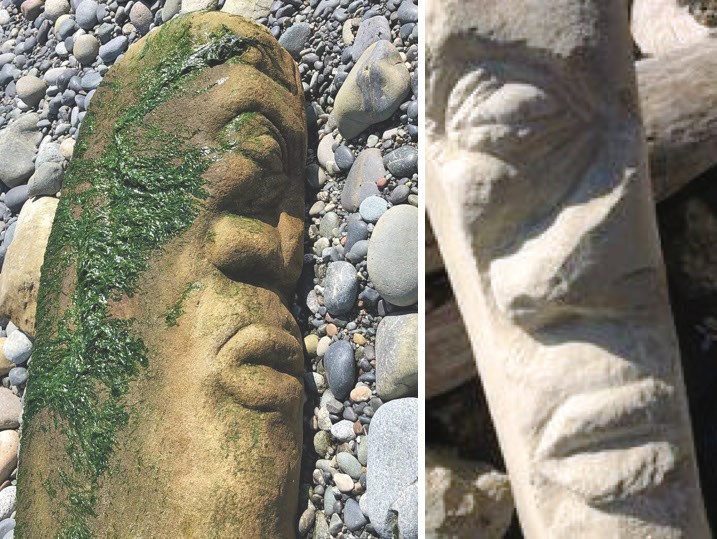A local artist says he couldn’t believe his eyes when he saw a photo of his rock carving being heralded as an Indigenous artifact by the Royal British Columbia Museum.
“I was totally surprised,” Ray Boudreau said. “It’s absolutely, 110 per cent my carving. I knew right away it was my carving. I looked at my phone frantically: ‘Oh yeah. There’s those pictures.’ ”
Boudreau’s photographs, with the date stamp Jan. 23, 2017, bear a strong resemblance to the 100-kilogram stone pillar found on a beach off Dallas Road at low tide last summer.
The museum announced last week the discovery of the stone pillar, and said it was likely used in rituals by the Songhees and Esquimalt First Nations.
The museum said the provenance of the pillar will be reviewed with the museum, the Songhees and Esquimalt First Nations and the carver.
Boudreau knew the stone was unusual. He found it a couple of days after two barges smashed into the shore near Dallas Road and Cook Street in late February 2016. One of the barges was loaded with heavy scrap and construction debris such as concrete and pilings from the Coho ferry terminal construction site.
He decided use the rock for a carving. “It’s a pretty nice rock. The stuff is so like butter. You hardly have to hammer the thing, it carves so clean and so easy. I fell right in love with this thing when I found it.”
When his carving disappeared from the beach, he assumed it had been stolen because he had tucked it way up on the shore.
“There’s no way the waves would ever take it away. But I thought: ‘Well, nobody really owns a rock.’ ”
The 65-year-old security guard believes people carried it off in a boat, but were forced to dump it.
Boudreau has been carving all his life, making leather saddles and leather book covers that have been sold all over the world. He has 10 rock carvings on the beach below Dallas Road.
At first, after the museum announcement, Boudreau wasn’t sure what to do.
“Do you shut your mouth about it or let it go? The thing took on a life of its own and it would have had a beautiful life if I hadn’t said anything.”
In the end, he decided the museum and the local First Nations should know the truth. “I didn’t want to live a lie,” he said.
Ron Sam, chief of the Songhees First Nation, said he has the assurance of the Royal B.C. Museum that steps will be taken to determine how the carved stone pillar came to be deemed an Indigenous artifact.
In a statement, museum CEO Jack Lohman said the museum’s Indigenous collections and repatriation department has been working closely with both the Songhees and Esquimalt First Nations to review and update its policies and procedures, “particularly with respect to historic works that surface or are excavated as part of local development projects.”
Sam said the museum called him on the day the 100-kilogram carving was hauled from the beach by the museum’s archeology curator and two other men who used a refrigeration dolly to move it.
“Somewhere, somebody in the museum made the determination that yes, it’s 110 per cent a First Nations artifact,” Sam said.
Elders would have provided input into the find but have not been able to see it at the museum due to pandemic restrictions, he said. “We haven’t engaged First Nations elders yet because we didn’t know exactly what we were dealing with.”
Lou-ann Neel, acting head of the museum’s Indigenous collection and repatriation department, said the carving received publicity after it was discussed on a blog written by Grant Keddie, the museum’s archeology curator. She decided the entry should be removed from the museum’s website for now.
Chiefs of both the Songhees and Esquimalt First Nations saw the pillar separately at the museum in September and seemed to suggest it could be related to other locally found items, though it was still partly covered in seaweed so its features may have been hard to identify, she said.
— With Camille Bains, The Canadian Press



